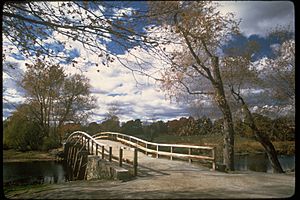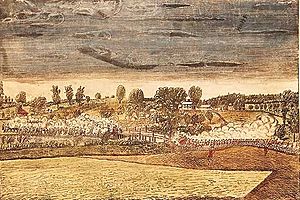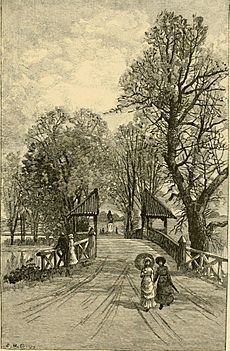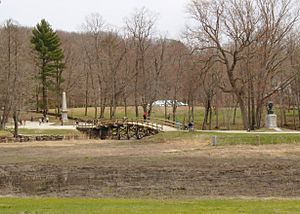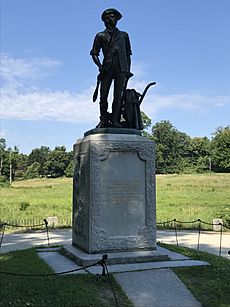Old North Bridge facts for kids
The Old North Bridge is a famous historical spot in Concord, Massachusetts. It crosses the Concord River. This bridge is known for a very important event that happened on April 19, 1775. This day was the start of the American Revolutionary War.
About 400 American minutemen and local militia soldiers faced off against about 90 British Army troops here. This battle was special because it was the first time American forces marched in an organized way against the British. They caused injuries and made the British soldiers retreat. This moment was a key part of the Battles of Lexington and Concord. It also became a major turning point in American history. The famous writer Ralph Waldo Emerson later called this event the "shot heard round the world."
The bridge you see today is not the original one. It's a wooden bridge built in 1956. It looks very much like the bridge that was there during the battle in 1775. This bridge was fixed up in 2005. The bridge and the land around it are part of the Minute Man National Historical Park. The National Park Service takes care of it. It's a popular place for people to visit and learn about history.
Contents
History of the Old North Bridge
The town of Concord was started in 1635. Over the next 20 years, settlers built farms north of the town center. Many of these farms were across the Concord River. To make it easier to get to town, farmers built a bridge over the river around the 1650s. Town records first mention a bridge here in 1654. The road crossing the bridge was later improved and called the Groton Road.
The river often flooded in the spring. This, along with normal wear and tear, meant the bridge had to be replaced often. A new bridge was built about every 20 to 30 years. Records show bridges were likely replaced in 1660, 1683, 1710, and 1731. The bridge built in 1760 was the one standing during the famous battle on April 19, 1775.
The "Concord Fight"
The fight at the North Bridge is known as the "Concord Fight." It was part of the bigger Battles of Lexington and Concord. On April 18, 1775, General Thomas Gage was the British military governor of Massachusetts. He sent about 700 British soldiers from Boston to take or destroy military supplies. These supplies were being stored in Concord by the rebellious Massachusetts Provincial Congress.
On their way to Concord, the British soldiers met a small group of militia on Lexington Green. After a short fight there, the British marched to Concord. When they arrived, Lieutenant Colonel Francis Smith sent six groups of soldiers across the North Bridge. Their job was to search Colonel James Barrett's farm for weapons. Three of these groups went to the farm. The other three, about 90 men, stayed to guard the North Bridge. These were British light infantry soldiers led by Captain Walter Laurie. They first stood on the west side of the bridge. But when the American militia advanced, they crossed the bridge and stood on the east side.
Around 10:30 AM, the American militia saw smoke rising from the village of Concord. The British soldiers had burned some wooden gun carriages they found. But the American militia thought the British were burning down the whole town. The Americans then marched in military order to take the bridge. They wanted to stop the British from burning the town. As they marched, the British fired a few warning shots, then a full volley. Several American soldiers were killed or hurt in this first round of shots.
Seeing their friends fall, Major John Buttrick of Concord gave a command. He yelled, "Fire, fellow soldiers, for God's sake fire!" The Americans fired back. The British immediately retreated back to Concord. Three British soldiers were killed and nine were wounded. On the American side, two were killed and four were wounded.
This was the first time Americans fought in an organized way and fired effectively at British troops. It was a major turning point in the Battles of Lexington and Concord. It made the British retreat back to Boston. This event is seen as one of the most important moments in American history.
Later Bridges at the Site
In 1788, a new bridge was built to replace the 1760 bridge that was there during the battle. As before, local farmers paid for this new bridge. In 1793, Concord built another new bridge a few hundred yards downriver. This made the North Bridge no longer needed. The road was moved to the new bridge, and the old road over the North Bridge was abandoned. That same year, the town allowed the North Bridge to be torn down. For the next 82 years, no bridge stood at the site.
In 1874, plans were made to celebrate 100 years since the battle. The town of Concord decided to put up a monument on the west side of the river. This is where the first minutemen died. They also decided to rebuild the North Bridge. This new bridge would not be for traffic. Instead, it would be part of the memorial. It would help visitors reach the new statue and see what the area looked like in 1775.
The Centennial Bridge, built in 1874, was described as "whimsical" and very rustic. It was designed by William Ralph Emerson, a cousin of the famous writer Ralph Waldo Emerson. The most unusual parts of this bridge were its two covered areas. They stuck out from the middle of the bridge and were covered with woven twigs.
The Centennial Bridge was washed away by spring floods in 1888. A simpler bridge replaced it that same year. William R. Emerson also designed this bridge, but without the fancy decorations. Even though it was made stronger with large oak posts, it was also washed out by floods in 1909. The Commonwealth of Massachusetts replaced the bridge in 1909. This bridge looked historically accurate, like the one in the Doolittle drawing. However, many people didn't like it because it was made of concrete.
The Current Bridge
In 1955, the 1909 concrete bridge was badly damaged by flooding from Hurricane Diane. At the same time, the town was thinking about how to better protect the monuments and land around the bridge. People in Concord protested, saying the new bridge should be made of wood, not concrete. Massachusetts politicians, including future Governor John Volpe, pushed for money from Congress, but it didn't pass. In 1956, the Commonwealth of Massachusetts started building a new bridge.
The state hired an architecture company called Whitman and Howard. Howard Perkins, an architect there, designed the new bridge. Perkins carefully studied the old Doolittle drawing. He created a design that looked like the 1760 bridge. His design had an arched pile bent bridge with six groups of three piles each. Perkins left out some details from the Doolittle drawing. He also added some things for strength, like beams that extend on either side of the bridge and cross braces. These additions make the bridge strong but also flexible during floods. The 1956 bridge used treated wood but also included hand-cut timbers to look authentic. The bridge is about 109 feet long. It was finished in September 1956 and officially opened on September 29, 1956.
In 1959, the bridge and the land around it became part of the Minute Man National Historical Park. When the park was added to the National Register of Historic Places in 1966, the bridge was listed as an important structure. It showed how important the place continued to be. In 2002, a study found that the bridge was getting old and needed repairs. After more studies, the Minute Man National Historical Park started a big restoration of the bridge in 2005.
Monuments at the Site
The 1836 Battle Monument
In 1835, there was no bridge at the site. Rev. Ezra Ripley, who lived nearby, gave a small piece of land to the town. This land would allow people to reach the planned monument on the east bank, where the Old North Bridge used to be. The land included part of the old Groton Road. It also had the graves of two British soldiers who died in the fight and were buried near the bridge.
The town of Concord built the 1836 Battle Monument with money from the Bunker Hill Monument Association. The tall, pointed monument was designed by Solomon Willard. It was placed on the land Ripley donated, near where the east end of the bridge had been. The words on the monument say: "HERE On the 19 of April, 1775, was made the first forcible resistance to British aggression / On the opposite Bank stood the American Militia / Here stood the Invading Army and on this spot the first of the Enemy fell in the War of that Revolution which gave Independence to these United States / In gratitude to GOD and In the love of Freedom this Monument was erected AD. 1836."
Concord dedicated the monument on Independence Day, July 4, 1837. Congressman Samuel Hoar gave a speech. For the event, Ralph Waldo Emerson wrote his "Concord Hymn." A choir sang this poem at the dedication. The first and most famous part of the poem is:
By the rude bridge that arched the flood,
Their flag to April's breeze unfurled,
Here once the embattled farmers stood
And fired the shot heard round the world.
These lines were later carved into the base of "The Minute Man" statue.
"The Minute Man" Statue
Some people in Concord were not happy with where the 1836 Battle Monument was placed. Since there was no bridge, the monument was on the east bank, where the British had stood. A farmer named Ebenezer Hubbard was especially bothered that the spot where the first Americans died was not marked. When he died in 1870, he left the town of Concord $1,000. This money was for a monument on the west side of the Concord River. It was also for rebuilding the Old North Bridge to reach it. People in Concord worked to finish both the new bridge and monument in time for the 100-year celebration in 1875.
Daniel Chester French, who was 21 years old, was hired to create a statue of a minuteman. He was asked to sculpt a general soldier. But French was inspired by the story of Captain Isaac Davis of Acton, Massachusetts. Captain Davis led the advance on the Old North Bridge. He was one of the first killed and the first American officer to die in the Revolution. French tried to make the statue's face look like photos of Isaac Davis's family members.
"The Minute Man" statue was revealed and dedicated on April 19, 1875. This was during the celebrations for the 100th anniversary of the Concord Fight. Then-President Ulysses S. Grant attended the ceremony. The statue was made from melted-down Civil War cannons at the Ames Foundry. "The Minute Man" has become a symbol for the United States National Guard. It has also appeared on coins, like the Massachusetts state quarter.
Graves of British Soldiers
Three British soldiers died during the Concord Fight. They were Privates James Hall, Thomas Smith, and Patrick Gray. All were from the 4th Regiment of Foot. One of these men was carried to Concord center, died, and was buried there. Two others died at the bridge. They were buried next to a stone wall near the Old Manse property. It's not known which two of the three are buried at the Old North Bridge site. At first, their graves were just marked by two plain stones. Nathaniel Hawthorne, who lived at the Old Manse for a time, called these stones a "humbler...yet more interesting" sign of the Concord Fight than the 1836 Battle Monument.
In 1875, a granite slab was placed there for the 100-year celebration. It simply said, "Grave of the British Soldiers." In 1910, people in Concord put a larger granite marker. It has a poem written by James Russell Lowell in 1849. The poem is called "Lines, Suggested By the Graves of Two English Soldiers On Concord Battle-Ground." The stanza on the marker reads:
They came three thousand miles and died
To keep the past upon its throne:
Unheard, beyond the ocean tide,
Their English Mother made her moan.
1975 Bicentennial Commemoration
On the 200th anniversary of the battle, President Gerald Ford gave a speech at the bridge. This was part of the United States Bicentennial celebrations. More than 15,000 people came to the event.


